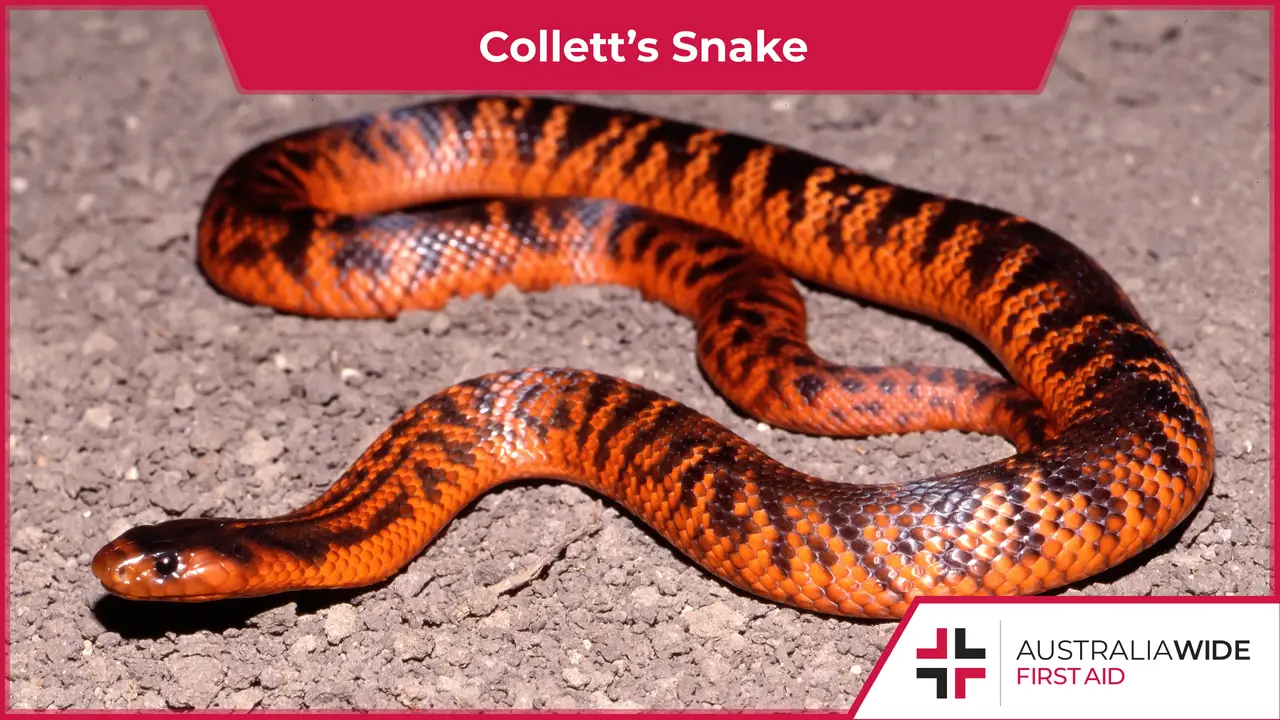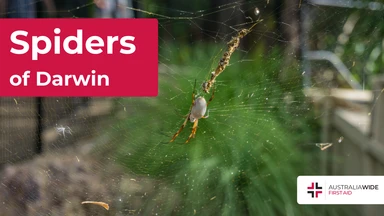First Aid for Collett's Snake


Collett's snake is renowned for a handful of reasons.
Not only is it one of Australia's most elusive snake species, it is also arguably our most vibrantly coloured one.
They are commonly misidentified as Tiger snakes, and though they are not closely related, both species have incredibly toxic venom that can destroy living cells.
Continue reading for more information on Collett's snake (Pseudechis colletti) and what to do if you are bitten by one.
We also cover snake bites in our following first aid courses:
To find a first aid course near you, simply head to our Locations page and follow the prompts.
Collett's snake has a a broad, blunt head that is near indistinct from its robust, strongly built body.
The scales on its top and sides are dark brown to black and covered in reddish to salmon-pink patches that form an irregular banded pattern.
The scales on its underside tend to range from yellow-orange to cream, while its head is uniformly dark, though sometimes with a paler snout.
Like the Blue belly black snake, Collett's snake generally has a total length of 1.5 metres and midbody scales 19 rows.
Collett's snake is generally found in drier areas of central to western Queensland.
In these areas, they tend to inhabit:
Though Collett's snake is active during the day and on warm evenings, they are secretive and rarely seen. In fact, their Conservation status is listed as 'Rare' in Queensland.
Their preferred prey include:
Like most snake species, females are oviparous and give birth to clutches of eggs, typically from October to December. Depending on the incubation temperature, these eggs can hatch up to 91 days later.
Collett's snake is considered a dangerously venomous snake.
However, it is important to remember that they are a relatively placid species and will only adopt a defensive display when threatened.
In the face of danger, they will firstly raise and inflate their forebody in a low curve and emit loud, short hisses until they tire and back away.
If this does not dissuade the offender, they will then strike out and attempt to bite.
The venom itself is highly dangerous, as it contains proteins that can cause muscle necrosis and damage to heart cells.
According to the National Center for Biotechnology Information, initial symptoms of a Collett's snake bite can include:
These can be followed in some cases by:
If you are bitten by Collett's snake, contact Triple Zero (000) for medical attention and apply the Pressure Immobilisation Technique, as described in our Snake Bite Identify and Treat article.
It is worthwhile noting, many snake species can vary in colour, pattern, and size, and so all snake bites should be considered a medical emergency.
Distributed in parts of central and western Queensland, Collett's snake is a reddish brown member of the Pseudechis genus that is considered dangerously venomous.
Their venom can breakdown muscle tissue and cause acute renal failure.
As such, if you are bitten by Collett s snake, or any one of the 200 known Australian snake species described by the Australian Museum, you should seek medical attention and apply the Pressure Immobilisation Technique.
You can learn even more about identifying and treating snake bites in our following first aid courses:
We offer these first aid courses in a variety of locations across central and western Queensland, including:
To find a first aid course near you, simply to head our Locations page and follow the prompts.

March 11, 2025
Darwin, the tropical capital of Australia’s Northern Territory, is home to a rich diversity of wildlife - including an impressive array of spiders. From the sprawling webs of golden orb-weavers to the cryptic camouflage of trapdoor spiders, these arachnids play a vital role in the local ecosystem. While some may inspire fear, the majority are harmless and even beneficial, helping to control insect populations.

September 4, 2024
Cat bites, while often underestimated, can lead to serious health complications if not treated promptly and properly. Cats' mouths harbour a variety of bacteria that can cause infections in humans.

April 1, 2024
Encounters with wildlife can often be thrilling, but when it comes to the creature known as the drop bear, the experience can quickly turn dangerous. A sharp increase in recent attacks prompts the need for understanding proper first aid procedures in case of an attack.